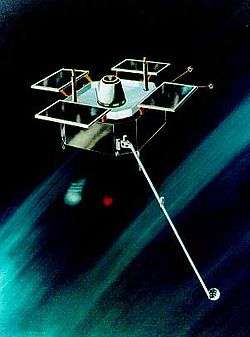Charge Composition Explorer
 Charge Composition Explorer (Explorer 65). | |
| Mission type | Magnetospheric research |
|---|---|
| Operator | NASA |
| COSPAR ID | 1984-088A[1] |
| SATCAT no. | 15199[1] |
| Spacecraft properties | |
| Launch mass | 242 kg (534 lb) |
| Power | 140 watts |
| Start of mission | |
| Launch date | 16 August 1984, 14:48 UTC[2] |
| Rocket | Delta-3924 D-175[3] |
| Launch site | Cape Canaveral LC-17A[4] |
| End of mission | |
| Last contact | July 18, 1989 |
| Orbital parameters | |
| Reference system | Geocentric |
| Regime | Highly Elliptical |
| Semi-major axis | 31,768.0 km (19,739.7 mi)[5] |
| Perigee | 993.5 km (617.3 mi)[5] |
| Apogee | 49,802.1 km (30,945.6 mi)[5] |
| Inclination | 2.9°[5] |
| Period | 939.2 minutes[5] |
Charge Composition Explorer, also called as CCE, AMPT/CCE, Explorer 65 or AMPTE 1, was a NASA satellite to studies of the magnetosphere, being launched as part of Explorers program. CCE was launched with the two other satellites of the AMPTE mission on August 16, 1984 from the Cape Canaveral launch pad by a Delta 3924 rocket. It is placed in an equatorial orbit of 1,100 kilometres (680 mi) × 50,000 kilometres (31,000 mi) with an inclination of 4.8 degrees. CCE is one of the components of the international space mission AMPTE, which also includes MRI, designed by West Germany, and UKS, provided by the United Kingdom.[1]
Characteristics
Charge Composition Explorer was instrumented to detect those lithium and barium tracer ions from the IRM released that were transported into the magnetosphere within the CCE orbit. The spacecraft was spin-stabilized at 10 rpm, with its spin axis in the equatorial plane, and offset from the earth-sun line by about 20 degrees. It could adjust attitude with both magnetic torqueing and cold gas thrusters.[1]
Instruments
The satellite carries 5 scientific instruments that are used to measure the composition of the particles in the magnetosphere throughout their energy spectrum and the changes that affect them with the objective of determining the main processes governing their excitation, their displacement and their disappearance. CCE must also detect the lithium and barium ions released by the MRI satellite and transported in the magnetosphere:[6]
- THPCE (Hot Plasma Composition Experiment): mass spectrometer designed to measure ions whose energy is less than 17 keV per electric charge. It includes an instrument to measure electrons with energy between 50 eV and 25 keV by breaking them into 8 energy bands.[7]
- MEPA (Medium Energy Particle Analyzer): measures the spectrum and energy of the magnetosphere particles whose energy per nucleon ranges from 10 keV (for oxygen) to 6 MeV.[8]
- CHEM (Charge-Energy-Mass Spectrometer): Mass spectrometer measures the mass, the charge and the energy spectrum and the incidence of the main ions whose atomic mass goes from hydrogen to iron and whose energy is between 0.3 keV and 300 keV.[9]
- PWE (Plasma Wave Experiment): measures plasma waves on 5 frequencies.[10]
- MAG (magnetometer): fluxgate magnetometer mounted at the end of a 2 metres (6.6 ft) rod.[11]
Result of the mission
Starting in 1989, the satellite encounters problems with the control module and the energy collection system and finally breaks down on July 18, 1989.[1]
References
- 1 2 3 4 5 "AMPTE/CCE". NSSDCA. NASA Goddard Space Flight Center. Retrieved 22 June 2018.

- ↑ "Jonathan's Space Page". McDowell, Joanthan. Retrieved June 22, 2018.
- ↑ "AMPTE". Encyclopedia Astronautica. Mark Wade. Retrieved 22 June 2018.
- ↑ "1964-076A - Explorer 24". Space 40 (in Czech). Lubor Lejček, Antonín Vítek. March 13, 2011. Retrieved 22 June 2018.
- 1 2 3 4 5 "CCE 1 (AMPTE)". n2yo.com. Retrieved 2018-06-22.
- ↑ "SAMPEX - Introduction". University of Colorado. Retrieved June 22, 2018.
- ↑ "AMPTE Mission Description". University of Maryland. Retrieved June 22, 2018.
- ↑ "APT-CCE: Medium-Energy Particle Analyzer (MEPA)". APL Johns Hopkins University. Retrieved June 22, 2018.
- ↑ "APT-CCE: Charge-Energy-Mass (CHEM) Spectrometer". APL Johns Hopkins University. Retrieved June 22, 2018.
- ↑ "APT-CCE: Plasma Wave Experiment (PWE)". APL Johns Hopkins University. Retrieved June 22, 2018.
- ↑ "APT-CCE : Magnetometer (MAG)". APL Johns Hopkins University. Retrieved June 22, 2018.
.png)